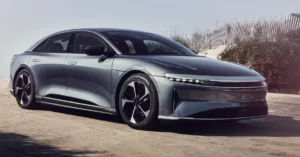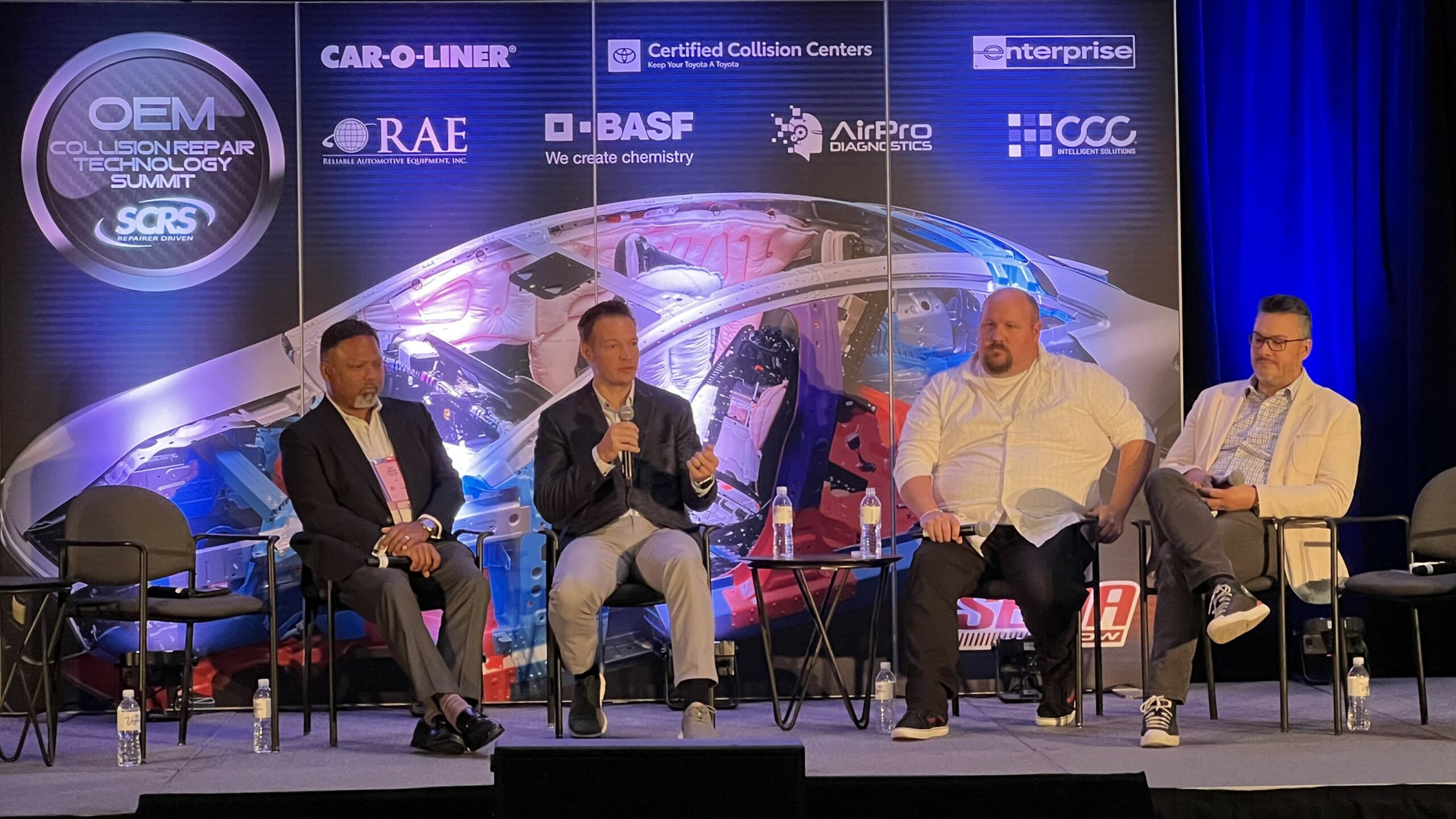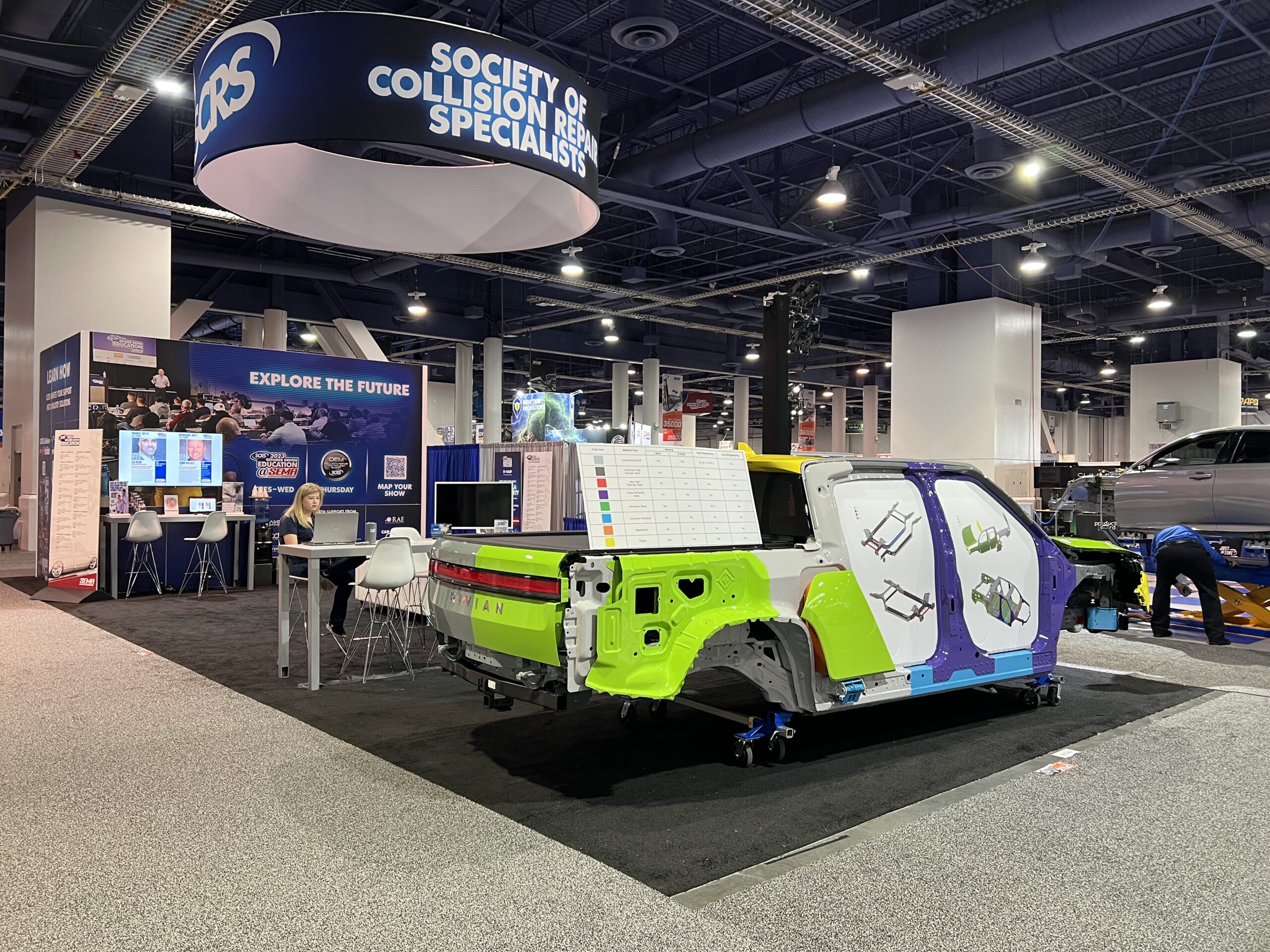
Details shared by Rivian and Lucid Motors during this year’s SEMA Show about the structural makeup of their vehicles fell in line with Ducker Carlisle’s forecast that the use of aluminum and composite materials will continue to rise through the end of the decade, with battery electric vehicles (BEVs) making up two-thirds of the market.
Rivian Collision Service Engineering Senior Manager Dan Black and Lucid Body Repair Technical Manager Matthew Pitta spoke and took questions from the audience during a session of this year’s Society of Collision Repair Specialists (SCRS)’ OEM Collision Repair Technology Summit, held on Nov. 2 in Las Vegas.
Black said the R1T and R1S are identical from the B pillar forward and the rest of both vehicles are built with common materials.
“Aluminum extrusions are not repairable because they have an intent to just absorb energy and lose all their value after that point in time,” Black said. “The body side is made up of conventional steel. The great thing about conventional steel is that’s where you can MIG weld, spot weld — all those conventional methods that you could do in the past, you do on this type of product as well. Our yellow-colored components throughout this entire layout are all composites. You have a header panel that’s bonded in with windshield ethane across the entire header of the vehicle.
“The lift gate in the rear is all composite on the R1S and then in the rear of the R1T, we have aluminum. Then the front nose, that’s all TPO — nothing unique and different; same common materials used throughout the entire industry.”
One unique component, he added, is the forward upper fascia, which has custom-milled thicknesses where the radar is located. “In that zone, it’s not repairable and that’s by intent because the radar needs to see through it. If there’s any additional obstruction, it cannot perform what it’s intended to do, which is to assist with other safety features. Aluminum intrusions are strategically placed in areas to protect the high-voltage system.”
Pitta said the Lucid Air is nearly 95% aluminum including a mix of stampings, castings, and extrusions including in the A and B pillars and roof. “It’s all about getting the car as light as possible.”
“We’ve got an aluminum extrusion reinforcement beam in the doors and then we have actually integrated cast components into the doors as well. We’re only replacing four components on the front of the car — the torque boxes, or the ring towers and the the front crash rails… It’s all about trying to minimize intrusion of components into the interior of the car.”
When asked at what point in the design of the cars the companies take into account repairability and how complex it is to integrate into the design, Pitta responded he and his team are “the last line of defense.”
“When an engineer wants to either change a part or they’re going to introduce a new part, we have to approve everything,” he said. “We get notified and then we look at all of the engineering notes and we say, ‘Is this repairable or does this affect an existing procedure?’ Sometimes we have to come back and say, ‘Guys, what you’ve done is not possible for us to repair in the body shop and if it’s a part that’s buried pretty deep in the car that means you’ve got to start back from the drawing board.’”
Black said Rivian works to ensure that any changes are interchangeable with the current design to make sure that it doesn’t deviate too far from the current strategy and product on the market. Rivian also doesn’t want to introduce additional complexity in terms of service parts, he said.
As far as investments that repair facilities have had to make, or would need to make if they’re accepted into Rivian or Lucid’s certified repair programs, aren’t as much as might be assumed.
Black said the main investment is a battery lift table, which can be picked from what’s already available in the industry. “We write recommendations but we also put out the threshold.”
The threshold is 3,000 pounds and may require some specific configurations, he said.
“We’ll sell you a jig that’s specific to our battery application to ensure stability in that instance so there’s some minor unique tooling… [and] adaptation to that particular piece of equipment that you’re using.”
Pitta added that there’s some crossover between Rivian and Lucid on equipment and tools when it comes to battery tables and advanced driver assistance systems (ADAS), adding that repairers can use what’s already available, such as certain welding and riveting tools.
Lucid is also trying to use 3D printing a lot, which Pitta said is “extremely underutilized” for repairability.
“A lot of our custom tooling that you would use for panel alignment, the radar fixture alignment — stuff like that — is 3D-printed. We make them out of a stout material like an ABS with carbon fiber infusement,” Pitta said.
That decreases the price from $300 to $12-$15, he said.
Black and Pitta were also asked if it’s true that their vehicles are more expensive to repair. Pitta said some procedures can be a little more difficult but common procedures such as to quarter panels, rear ends, and quarter skins aren’t. For example, quarter skins take 2.5 hours to replace after teardown with all the tools laid out and ready to go, he said.
“The reason the repairs are getting expensive is the technology side of it — all the ADAS stuff, all of the programming, all of the firmware,” Pitta said. “You replace a module on a car, you might have to do firmware updates for two days sometimes to get everything else up to that level.”
He added that if all of that and ADAS calibrations can be streamlined to bring labor times down, costs should come down some.
Black agreed and said that Rivian is always investigating ways to bring costs down.
“The complexity from a repair standpoint, at least from a rant standpoint on the structure side isn’t not there, in my opinion, in terms of what we’ve driven into the product, we try to simplify it as much as we could from a repair repairability perspective, which ultimately drives down the time investment. So if you can drive down the time investment, it reduces the cost repair rate. And that’s kind of the trade-off.”
An audience member then suggested a CIECA standard be developed for service information.
“A standard would be great for a consistent process flow and documentation in the way that you access it,” Black said. “A lot of it, we’re held to standards internally that are somewhat beyond some of our controls… it’s definitely something we’ll take back and investigate how we can improve the accessibility of our content, not just getting to it but navigating it; ensuring it’s a consistent flow with how other OEMs structure their content.”
Pitta answered, “I think a lot of that is going to be internal departments. We don’t want to separate ourselves from everyone else. That’s a topic that has been sent to us a lot… I do agree that that would be a great thing for the industry. It’s going to require everyone though to come together and drop [the] ‘I want to puff up my shoulders and just say we need one way of doing this.’”
In their closing comments, Black emphasized repairers should always access repair procedures with every repair and Pitta encouraged asking questions.
“I don’t care if you look at the procedure yesterday, it could change tomorrow, particularly in an environment that I’m in where there’s rapid change,” Black said. “As there’s rapid change, there’s rapid enhancements of your content. We don’t know where we’re going to stand in this position from a repairability perspective from today to tomorrow.”
Pitta added, “When you guys are looking at things, if you catch something, even if it’s a spelling error, send it to us because in reviewing that, we always catch the, we caught something else, we caught something else and it makes the procedure better. You guys help us make it better. We help you succeed. It’s a very somatic relationship.”
In presentations given by Ducker Carlisle during the summit session, Automotive and Materials Principal Abey Abraham and Director and Global Automotive Practice Leader Bertrand Rakoto shared that it’s predicted 85% of the market will be light-duty trucks within the next few years, meaning more lightweighting to offset the often-heavy makeup of the vehicles.
“The change in the mix, the change in the market structure, in North America is also because, since COVID, we’ve seen the average price point of a vehicle jumping from $37,000 for an average new vehicle sold to $46,000,” he said. “The higher price points means also larger vehicles of course, but also for carmakers, they can make a little more margin.”
And more margin means more money for additional technology, more aluminum casting in the body-in-white, plastic fenders, and more, Rakoto added.
“Right now, the price point for BEVs is $66,000 [on] average, which means automakers have to pack a little more technology in there or the vehicles are a little more expensive to make,” Rakoto said.
Between model years 2027 and 2032 the Environmental Protection Agency (EPA) proposes automakers should reduce carbon dioxide emissions by 66% but in order for that to happen more needs to be done than just increasing the number of BEVs that go to market, Rakotoa said.
That could come in three ways using eight, nine, or 10-speed gearboxes in ICE vehicles, downsizing Ecoboost-type engines; lightweighting or using alternative or synthetic fuels, such as hydrogen.
Abraham noted that the automakers’ preference for monolithic material vehicles, made mostly of varying steel thicknesses, is no longer considered.
“In the last 15 years, we’ve seen a lot of innovation in steel and, of course, aluminum isn’t a new material to the industry either,” he said. “The use of aluminum today for its purposes are pretty stellar. In the past, we’ve seen aluminum used for performance gains, better handling, better acceleration, better braking and that transitions to nowadays as well.
“Aluminum is a very comfortable material to work with right now for both the OEMs and the repair markets but as we continue to evolve with the joining technologies, it’s not just welding a vehicle anymore.”
Images
Featured image: Lucid Air Pure (Provided by Lucid)
(From left) Abey Abraham, Dan Black, Matthew Pitta, and Bertrand Rakoto participated in one of three SCRS OEM Collision Repair Technology Summit sessions on Nov. 2, 2023 during the SEMA Show in Las Vegas. (Courtesy of SCRS)
A Rivian R1T body-in-white sat at the Society of Collision Repair Specialists (SCRS) booth during the 2023 SEMA Show. (Courtesy of SCRS)
This article is care of https://www.repairerdrivennews.com/2023/11/14/ev-makers-say-materials-used-common-repairs-arent-always-more-expensive/



